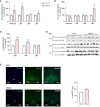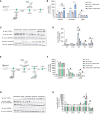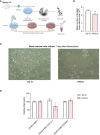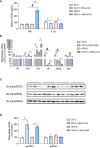Maternal consumption of a high-fat diet modulates the inflammatory response in their offspring, mediated by the M1 muscarinic receptor
- PMID: 38193079
- PMCID: PMC10773672
- DOI: 10.3389/fimmu.2023.1273556
Maternal consumption of a high-fat diet modulates the inflammatory response in their offspring, mediated by the M1 muscarinic receptor
Abstract
Introduction: High-fat diet (HFD) consumption is associated with various metabolic disorders and diseases. Both pre-pregnancy and maternal obesity can have long-term consequences on offspring health. Furthermore, consuming an HFD in adulthood significantly increases the risk of obesity and metabolic disorders. However, an intriguing phenomenon known as the obesity paradox suggests that obesity may confer a protective effect on mortality outcomes in sepsis. In sepsis, activation of the cholinergic anti-inflammatory pathway (CAP) can help mitigate systemic inflammation. We employed a metabolic programming model to explore the relationship between maternal HFD consumption and offspring response to sepsis.
Methods: We fed female mice either a standard diet (SC) or an HFD during the pre-pregnancy, pregnancy, and lactation periods. Subsequently, we evaluated 28-day-old male offspring.
Results: Notably, we discovered that offspring from HFD-fed dams (HFD-O) exhibited a higher survival rate compared with offspring from SC-fed dams (SC-O). Importantly, inhibition of the m1 muscarinic acetylcholine receptor (m1mAChR), involved in the CAP, in the hypothalamus abolished this protection. The expression of m1mAChR in the hypothalamus was higher in HFD-O at different ages, peaking on day 28. Treatment with an m1mAChR agonist could modulate the inflammatory response in peripheral tissues. Specifically, CAP activation was greater in the liver of HFD-O following agonist treatment. Interestingly, lipopolysaccharide (LPS) challenge failed to induce a more inflammatory state in HFD-O, in contrast to SC-O, and agonist treatment had no additional effect. Analysis of spleen immune cells revealed a distinct phenotype in HFD-O, characterized by elevated levels of CD4+ lymphocytes rather than CD8+ lymphocytes. Moreover, basal Il17 messenger RNA (mRNA) levels were lower while Il22 mRNA levels were higher in HFD-O, and we observed the same pattern after LPS challenge.
Discussion: Further examination of myeloid cells isolated from bone marrow and allowed to differentiate showed that HFD-O macrophages displayed an anti-inflammatory phenotype. Additionally, treatment with the m1mAChR agonist contributed to reducing inflammatory marker levels in both groups. In summary, our findings demonstrate that HFD-O are protected against LPS-induced sepsis, and this protection is mediated by the central m1mAChR. Moreover, the inflammatory response in the liver, spleen, and bone marrow-differentiated macrophages is diminished. However, more extensive analysis is necessary to elucidate the specific mechanisms by which m1mAChR modulates the immune response during sepsis.
Keywords: DOHaD (Developmental origins of health and disease); cholinergic; high fat diet (HFD); hypothalamus; maternal programming; muscarinic 1 acetylcholine receptors; obesity.
Copyright © 2023 Costa, Chaves, Lopes, Silva, Burguer, Ignácio-Souza, Torsoni, Milanski, Rodrigues, Desai, Ross and Torsoni.
Conflict of interest statement
The authors declare that the research was conducted in the absence of any commercial or financial relationships that could be construed as a potential conflict of interest.
Figures







References
Publication types
MeSH terms
Substances
Grants and funding
LinkOut - more resources
Full Text Sources
Medical
Research Materials
Miscellaneous

